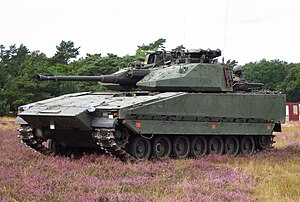CV90
| Combat Vehicle 90 | |
|---|---|

A Strf9040C in Swedish service
|
|
| Type | Infantry fighting vehicle |
| Place of origin | Sweden |
| Service history | |
| In service | 1993–present |
| Used by | See Operators |
| Wars |
War in Afghanistan United Nations Mission in Liberia |
| Production history | |
| Designer | Hägglunds/Bofors |
| Manufacturer | BAE Systems AB |
| No. built | Over 1,000 |
| Specifications | |
| Weight | 23–35 tonnes (Mk0 to MkIII) |
| Length | 6.55 m |
| Width | 3.1 m |
| Height | 2.7 m |
| Crew | 3 (commander, gunner, driver) 8 troopers |
|
|
|
|
Main
armament |
40mm Bofors Autocannon, 30mm Bushmaster Cannon (export model MkI & MkII) 35mm/50 Bushmaster Cannon (export model MkIII) |
|
Secondary
armament |
7.62 mm Ksp m/39 machine gun 6 × 76 mm grenade launchers |
| Engine |
Scania DSI 14 litres or DSI 16, V8 Diesel 550–810 hp (410–595 kW) 2,300 Nm |
| Power/weight | 24.1 hp/tonne |
| Transmission | Automatic |
| Suspension | torsion bar |
|
Operational
range |
320 km |
| Speed | 70 km/h |
The Stridsfordon 90 (Strf 90; Eng. Combat Vehicle 90, CV90) is a family of Swedish tracked combat vehicles designed by FMV, Hägglunds and Bofors during the mid-1980s and early 1990s. The Swedish version of the main infantry fighting vehicle is fitted with a turret from Bofors that is equipped with a 40 mm autocannon, although export versions use 30 mm and 35 mm autocannons. Developed specifically for the Nordic sub-arctic climate, it has very good mobility in snow and wetlands while carrying and supporting eight (later versions were reduced to six) fully equipped soldiers. Other variants include Forward Observation, Command and Control, Anti-air, Armoured Recovery, Electronic Warfare and so forth. It is still produced and being developed by BAE Systems Hägglunds AB.
During the Cold War, in 1983, the Swedish Army required vehicles with high mobility, air defence and anti-tank capability, high survivability and protection. The project group "Stridsfordon 90" was formed by representatives from the Swedish armed forces (Försvarsmakten), the Defense Materiel Administration (Försvarets Materielverk) and Swedish industry including Hägglunds and Bofors, which in 1985 finalized the design for a "unity-vehicle" which originated from an airforce concept. In 1986, the prototypes for Strf 9040 and Strf 9025 were ordered. Five prototypes were constructed, but before delivery in 1988, the 9025-version was discontinued. These prototypes were tested during extensive trials for three years between 1988 and 1991, during which the prototypes for specialized variants (FOV, C&C and ARV) were ordered. The first deliveries started in 1994, and as of 2002 over 1,000 CV90s have been delivered worldwide.
Various customer requirements have led to several variants of the CV90, where major differences are in survivability and electronic architecture. Higher protection has led to higher kerb weight; the vehicle's combat weight has risen from 23 to 35 tonnes. However, with increasingly more powerful diesel engines, the power-to-weight ratio has remained approximately the same. The track suspension system has seen upgrades in several stages. The Mk III version has a digital electronic architecture with several different CAN-buses and digital networks, and is the first IFV incorporating an automatic Defensive Aid Suite (DAS), which classifies threats and, in automatic mode, can fire smoke and/or the main gun to eliminate or evade targets as well as instruct the driver. At the Eurosatory 2010 exhibition, a version called Armadillo was presented. The Armadillo shown was an Armoured Personnel Carrier (APC) version. The basic chassis can be readily converted to ambulance, control vehicle or other turreted versions.
...
Wikipedia
